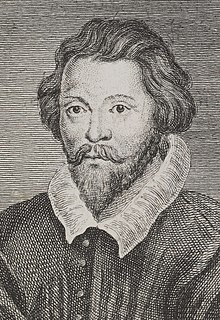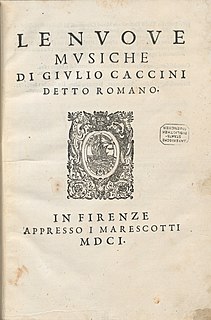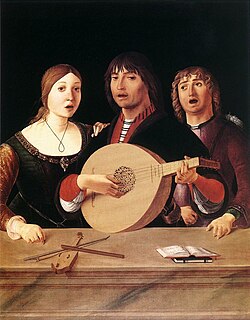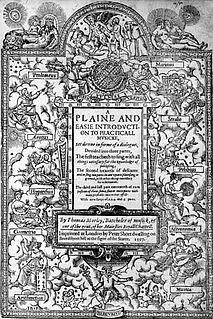The estampie is a medieval dance and musical form which was a popular instrumental and vocal form in the 13th and 14th centuries. The name was also applied to poetry.

William Byrd was an English composer of the Renaissance. Widely considered to be one of the greatest composers of the Renaissance and one of the greatest British composers, he had a huge influence on composers both from his native England and those on the continent. He wrote in many of the forms current in England at the time, including various types of sacred and secular polyphony, keyboard, and consort music. Although he produced sacred music for Anglican services, sometime during the 1570s he became a Roman Catholic and wrote Catholic sacred music later in his life.

A madrigal is a secular vocal music composition of the Renaissance and early Baroque (1600–1750) eras. The polyphonic madrigal is unaccompanied, and the number of voices varies from two to eight, but usually features three to six voices, whilst the metre of the madrigal varies between two or three tercets, followed by one or two couplets. Unlike the verse-repeating strophic forms sung to the same music, most madrigals are through-composed, featuring different music for each stanza of lyrics, whereby the composer expresses the emotions contained in each line and in single words of the poem being sung.

In poetry, the term monody has become specialized to refer to a poem in which one person laments another's death.

The term lute song is given to a music style from the late 16th century to early 17th century, late Renaissance to early Baroque, that was predominantly in England and France. Lute songs were generally in strophic form or verse repeating with a homophonic texture. The composition was written for a solo voice with an accompaniment, usually the lute. It was not uncommon for other forms of accompaniments such as bass viol or other string instruments, and could also be written for more voices. The composition could be performed either solo or with a small group of instruments.

Thomas Morley was an English composer, theorist, singer and organist of the Renaissance. He was one of the foremost members of the English Madrigal School. Referring to the strong Italian influence on the English madrigal, The New Grove Dictionary of Music and Musicians states that Morley was "chiefly responsible for grafting the Italian shoot on to the native stock and initiating the curiously brief but brilliant flowering of the madrigal that constitutes one of the most colourful episodes in the history of English music."
A fantasia is a musical composition with roots in improvisation. The fantasia, like the impromptu, seldom follows the textbook rules of any strict musical form.
In music, a chorale monody was a type of a sacred composition of the very early German Baroque era. It was for solo voice and accompanying instruments, usually basso continuo, and was closely related to the contemporary Italian style of monody. Almost all examples of chorale monodies were written in the first half of the 17th century.

A consort of instruments was a phrase used in England during the 16th and 17th centuries to indicate an instrumental ensemble. These could be of the same or a variety of instruments. Consort music enjoyed considerable popularity at court and in households of the wealthy in the Elizabethan era and many pieces were written for consorts by the major composers of the period. In the Baroque era consort music was absorbed into chamber music.

During the reign of Queen Elizabeth I (1558–1603), English art and high culture reached a pinnacle known as the height of the English Renaissance. Elizabethan music experienced a shift in popularity from sacred to secular music and the rise of instrumental music. Professional musicians were employed by the Church of England, the nobility, and the rising middle-class.
The year 1632 in music involved some significant events.
The year 1617 in music involved some significant events.
Martin Peerson was an English composer, organist and virginalist. Despite Roman Catholic leanings at a time when it was illegal not to subscribe to Church of England beliefs and practices, he was highly esteemed for his musical abilities and held posts at St Paul's Cathedral and, it is believed, Westminster Abbey. His output included both sacred and secular music in forms such as consort music, keyboard pieces, madrigals and motets.

Early music of the British Isles, from the earliest recorded times until the beginnings of the Baroque in the 17th century, was a diverse and rich culture, including sacred and secular music and ranging from the popular to the elite. Each of the major nations of England, Ireland, Scotland and Wales retained unique forms of music and of instrumentation, but British music was highly influenced by continental developments, while British composers made an important contribution to many of the major movements in early music in Europe, including the polyphony of the Ars Nova and laid some of the foundations of later national and international classical music. Musicians from the British Isles also developed some distinctive forms of music, including Celtic chant, the Contenance Angloise, the rota, polyphonic votive antiphons and the carol in the medieval era and English madrigals, lute ayres and masques in the Renaissance era, which would lead to the development of English language opera at the height of the Baroque in the 18th century.

Philip Brett was a British-born American musicologist, musician and conductor. He was particularly known for his scholarly studies on Benjamin Britten and William Byrd and for his contributions to the development of lesbian and gay musicology. At the time of his death, he was Distinguished Professor of Musicology at the University of California, Los Angeles.

Drexel 4180–4185 is a set of six manuscript partbooks copied in Gloucester, England, containing primarily vocal music dating from approximately 1615-1625. Considered one of the most important sources for seventeenth century English secular song, the repertoire included represents a mixture of sacred and secular music, attesting to the partbooks' use for entertainment and pleasure, rather than exclusively for liturgical use.

Edward Paston (1550–1630), second son of Sir Thomas Paston, was a Catholic gentleman of Norfolk, a poet, and amateur musician living in the reign of Elizabeth I. He is an important figure in the musical history of England, his love of music driving him to acquire and copy musical manuscripts from some of the most important composers of the Renaissance, resulting in a unique performing collection of 16th-century house music that included works by William Byrd, Thomas Tallis, John Taverner, and Orlando di Lasso. He was especially interested in Byrd, and one of his books is the largest source of consort songs by that composer. Paston played the lute, creating a wide range of vocal settings and accompanying tablatures in partbooks that are still obtainable. As a young man he travelled extensively in Spain, being influenced by the Spanish form of tablature, as seen in his partbooks, rather than the generally used French form.










